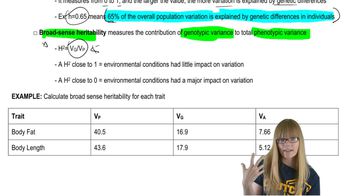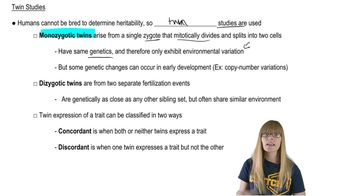Table of contents
- 1. Introduction to Genetics51m
- 2. Mendel's Laws of Inheritance3h 37m
- 3. Extensions to Mendelian Inheritance2h 41m
- 4. Genetic Mapping and Linkage2h 28m
- 5. Genetics of Bacteria and Viruses1h 21m
- 6. Chromosomal Variation1h 48m
- 7. DNA and Chromosome Structure56m
- 8. DNA Replication1h 10m
- 9. Mitosis and Meiosis1h 34m
- 10. Transcription1h 0m
- 11. Translation58m
- 12. Gene Regulation in Prokaryotes1h 19m
- 13. Gene Regulation in Eukaryotes44m
- 14. Genetic Control of Development44m
- 15. Genomes and Genomics1h 50m
- 16. Transposable Elements47m
- 17. Mutation, Repair, and Recombination1h 6m
- 18. Molecular Genetic Tools19m
- 19. Cancer Genetics29m
- 20. Quantitative Genetics1h 26m
- 21. Population Genetics50m
- 22. Evolutionary Genetics29m
20. Quantitative Genetics
Heritability
Problem 17
Textbook Question
Suppose you want to develop a population of Drosophila that would rapidly learn to avoid certain substances the flies could detect by smell. Based on the heritability estimate you obtained in Problem 16, do you think it would be worth doing this by artificial selection? Why or why not?
 Verified step by step guidance
Verified step by step guidance1
<span>Step 1: Understand the concept of heritability. Heritability is a measure of how much of the variation in a trait can be attributed to genetic differences among individuals in a population. It ranges from 0 to 1, where 0 means no genetic contribution and 1 means all variation is genetic.</span>
<span>Step 2: Recall the heritability estimate from Problem 16. This value will help determine the potential success of artificial selection. A high heritability suggests that the trait is largely influenced by genetics and can be effectively selected for.</span>
<span>Step 3: Consider the implications of a high heritability estimate. If the heritability is high, it indicates that the trait of learning to avoid certain substances is strongly influenced by genetics, making artificial selection a viable strategy.</span>
<span>Step 4: Evaluate the potential for rapid change. With a high heritability, the population can be expected to respond quickly to selection, as the genetic basis for the trait is strong.</span>
<span>Step 5: Make a decision based on heritability. If the heritability is low, it suggests that environmental factors play a larger role, and artificial selection may not be as effective. If high, it would be worth pursuing artificial selection to develop the desired trait.</span>
Recommended similar problem, with video answer:
 Verified Solution
Verified SolutionThis video solution was recommended by our tutors as helpful for the problem above
Video duration:
4mPlay a video:
Was this helpful?
Key Concepts
Here are the essential concepts you must grasp in order to answer the question correctly.
Heritability
Heritability is a measure of how much of the variation in a trait within a population can be attributed to genetic differences among individuals. It is expressed as a value between 0 and 1, where a higher value indicates a greater genetic contribution to the trait. Understanding heritability is crucial for predicting whether traits can be effectively altered through selective breeding.
Recommended video:
Guided course

Calculating Heritability
Artificial Selection
Artificial selection is the process by which humans breed plants and animals for specific traits. This method relies on selecting individuals with desirable characteristics to reproduce, thereby increasing the frequency of those traits in future generations. Evaluating the feasibility of using artificial selection in Drosophila requires understanding the heritability of the learning behavior in question.
Recommended video:
Guided course

Artificial Selection
Learning and Memory in Drosophila
Drosophila, or fruit flies, are widely used in genetic studies due to their relatively simple nervous system and well-understood genetics. They exhibit various forms of learning and memory, particularly in response to olfactory cues. Investigating the genetic basis of these behaviors can inform whether artificial selection could effectively enhance their ability to learn to avoid certain substances.
Recommended video:
Guided course

Drosophila P Element

 7:04m
7:04mWatch next
Master Calculating Heritability with a bite sized video explanation from Kylia Goodner
Start learning

